- Home
- Toni Morrison
The Source of Self-Regard Page 21
The Source of Self-Regard Read online
Page 21
However, a problem, unsolved, lies in the central chamber of the novel. The shattered world I built (to complement what is happening to Pecola), its pieces held together by seasons in childtime and commenting at every turn on the incompatible and barren white-family primer, does not in its present form handle effectively the silence at its center. The void that is Pecola’s “unbeing.” It should have had a shape—like the emptiness left by a boom or a cry. It required a sophistication unavailable to me, and some deft manipulation of the voices around her. She is not seen by herself until she hallucinates a self. And the fact of her hallucination becomes a point of outside-the-book conversation, but does not work in the reading process.
Also, although I was pressing for a female expressiveness (a challenge that resurfaced in Sula), it eluded me for the most part, and I had to content myself with female personae because I was not able to secure throughout the work the feminine subtext that is present in the opening sentence (the women gossiping, eager and aghast in “Quiet as it’s kept”). The shambles this struggle became is most evident in the section on Pauline Breedlove where I resorted to two voices, hers and the urging narrator’s, both of which are extremely unsatisfactory to me. It is interesting to me now that where I thought I would have the most difficulty subverting the language to a feminine mode, I had the least: connecting Cholly’s “rape” by the white men to his own of his daughter. This most masculine act of aggression becomes feminized in my language, “passive,” and, I think, more accurately repellent when deprived of the male “glamor of shame” rape is (or once was) routinely given.
The points I have tried to illustrate are that my choices of language (speakerly, aural, colloquial), my reliance for full comprehension on codes embedded in black culture, my effort to effect immediate coconspiracy and intimacy (without any distancing, explanatory fabric), as well as my (failed) attempt to shape a silence while breaking it are attempts (many unsatisfactory) to transfigure the complexity and wealth of Afro-American culture into a language worthy of the culture.
In Sula, it’s necessary to concentrate on two first sentences because what survives in print is not the one I had intended to be the first. Originally the book opened with “Except for World War II nothing ever interfered with National Suicide Day.” With some encouragement, I recognized that it was a false beginning. “In medias res” with a vengeance, because there was no res to be in the middle of—no implied world in which to locate the specificity and the resonances in the sentence. More to the point, I knew I was writing a second novel, and that it too would be about people in a black community not just foregrounded but totally dominant, and that it was about black women—also foregrounded and dominant. In 1988, certainly, I would not need (or feel the need for) the sentence—the short section—that now opens Sula. The threshold between the reader and the black-topic text need not be the safe, welcoming lobby I persuaded myself it needed at that time. My preference was the demolition of the lobby altogether. As can be seen from The Bluest Eye, and in every other book I have written, only Sula has this “entrance.” The others refuse the “presentation”; refuse the seductive safe harbor, the line of demarcation between the sacred and the obscene, public and private, them and us. Refuse, in effect, to cater to the diminished expectations of the reader, or his or her alarm heightened by the emotional luggage one carries into the black-topic text. (I should remind you that Sula was begun in 1969, while my first book was in proof, in a period of extraordinary political activity.)
Since I had become convinced that the effectiveness of the original beginning was only in my head, the job at hand became how to construct an alternate beginning that would not force the work to genuflect and would complement the outlaw quality in it. The problem presented itself this way: to fashion a door. Instead of having the text open wide the moment the cover is opened (or, as in The Bluest Eye, to have the book stand exposed before the cover is even touched, much less opened, by placing the complete “plot” on the first page—and finally on the jacket of the first edition), here I was to posit a door, turn its knob, and beckon for some four or five pages. I had determined not to mention any characters in those pages, there would be no people in the lobby—but I did, rather heavy-handedly in my view, end the welcome aboard with the mention of Shadrack and Sula. It was a craven (to me, still) surrender to a worn-out technique of novel writing: the overt announcement to the reader whom to pay attention to. Yet the bulk of the opening I finally wrote is about the community, a view of it, and the view is not from within (this is a door, after all) but from the point of view of a stranger—the “valley man” who might happen to be there on some errand, but who obviously does not live there and to and for whom all this is mightily strange, even exotic. You can see why I despise much of this beginning. Yet I tried to place in the opening sentence the signature terms of loss: “There used to be a neighborhood here; not anymore.” That may not be the world’s worst sentence, but it doesn’t “play,” as they say in the theater.
My new first sentence became “In that place, where they tore the nightshade and blackberry patches from their roots to make room for the Medallion City Golf Course, there was once a neighborhood.” Instead of my original plan, here I am introducing an outside-the-circle reader into the circle. I am translating the anonymous into the specific, a “place” into a “neighborhood,” and letting a stranger in through whose eyes it can be viewed. In between “place” and “neighborhood” I now have to squeeze the specificity and the difference; the nostalgia, the history, and the nostalgia for the history; the violence done to it and the consequences of that violence. (It took three months, those four pages, a whole summer of nights.) The nostalgia is sounded by “once”; the history and a longing for it is implied in the connotation of “neighborhood.” The violence lurks in having something torn out by its roots—it will not, cannot grow again. Its consequences are that what has been destroyed is considered weeds, refuse necessarily removed in urban “development” by the unspecified but no less known “they” who do not, cannot, afford to differentiate what is displaced, and would not care that this is “refuse” of a certain kind. Both plants have darkness in them: “black” and “night.” One is unusual (nightshade) and has two darkness words: “night” and “shade.” The other (blackberry) is common. A familiar plant and an exotic one. A harmless one and a dangerous one. One produces a nourishing berry; one delivers toxic ones. But they both thrived there together, in that place when it was a neighborhood. Both are gone now, and the description that follows is of the other specific things, in this black community, destroyed in the wake of the golf course. “Golf course” conveys what it is not, in this context: not houses, or factories, or even a public park, and certainly not residents. It is a manicured place where the likelihood of the former residents showing up is almost nil.
I want to get back to those berries for a moment (to explain, perhaps, the length of time it took for the language of that section to arrive). I always thought of Sula as quintessentially black, metaphysically black, if you will, which is not melanin and certainly not unquestioning fidelity to the tribe. She is New World black and New World woman extracting choice from choicelessness, responding inventively to found things. Improvisational. Daring, disruptive, imaginative, modern, out-of-the-house, outlawed, unpolicing, uncontained, and uncontainable. And dangerously female. In her final conversation with Nel she refers to herself as a special kind of black person woman, one with choices. Like a redwood, she says. (With all due respect to the dream landscape of Freud, trees have always seemed feminine to me.) In any case, my perception of Sula’s double-dose of chosen blackness and biological blackness is in the presence of those two words of darkness in “nightshade” as well as in the uncommon quality of the vine itself. One variety is called “enchanter,” and the other “bittersweet” because the berries taste bitter at first and then sweet. Also nightshade was thought to counteract witchcraft. All of this seemed a w
onderful constellation of signs for Sula. And “blackberry patches” seemed equally appropriate for Nel: nourishing, never needing to be tended or cultivated, once rooted and bearing. Reliably sweet but thorn-bound. Her process of becoming, heralded by the explosive dissolving of her fragilely-held-together ball of string and fur (when the thorns of her self-protection are removed by Eva), puts her back in touch with the complex, contradictory, evasive, independent, liquid modernity Sula insisted upon. A modernity that overturns prewar definitions, ushers in the Jazz Age (an age defined by Afro-American art and culture), and requires new kinds of intelligences to define oneself.
The stage-setting of the first four pages is embarrassing to me now, but the pains I have taken to explain it may be helpful in identifying the strategies one can be forced to resort to in trying to accommodate the mere fact of writing about, for, and out of black culture while accommodating and responding to mainstream “white” culture. The “valley man’s” guidance into the territory was my compromise. Perhaps it “worked,” but it was not the work I wanted to do.
Had I begun with Shadrack, I would have ignored the smiling welcome and put the reader into immediate confrontation with his wound and his scar. The difference my preferred (original) beginning would have made would be calling greater attention to the traumatic displacement this most wasteful capitalist war had on black people in particular, and throwing into relief the creative, if outlawed, determination to survive it whole. Sula as (feminine) solubility and Shadrack’s (male) fixative are two extreme ways of dealing with displacement—a prevalent theme in the narrative of black people. In the final opening I replicated the demiurge of discriminatory, prosecutorial racial oppression in the loss to commercial “progress” of the village, but the references to the community’s stability and creativeness (music, dancing, craft, religion, irony, wit all referred to in the “valley man’s” presence) refract and subsume their pain while they are in the thick of it. It is a softer embrace than Shadrack’s organized, public madness—his disruptive remembering presence, which helps (for a while) to cement the community, until Sula challenges them.
“The North Carolina Mutual Life Insurance agent promised to fly from Mercy to the other side of Lake Superior at three o’clock.”
This declarative sentence is designed to mock a journalistic style; with a minor alteration it could be the opening of an item in a small-town newspaper. It has the tone of an everyday event of minimal local interest, yet I wanted it to contain (as does the scene that takes place when the agent fulfills his promise) the information that Song of Solomon both centers on and radiates from.
The name of the insurance company is real, a well-known black-owned company dependent on black clients, and in its corporate name are “life” and “mutual,” “agent” being the necessary ingredient of what enables the relationship between them. The sentence also moves from North Carolina to Lake Superior—geographical locations, but with a sly implication that the move from North Carolina (the South) to Lake Superior (the North) might not actually involve progress to some “superior state”—which, of course, it does not. The two other significant words are “fly,” upon which the novel centers, and “Mercy,” the name of the place from which he is to fly. Both constitute the heartbeat of the narrative. Where is the insurance man flying to? The other side of Lake Superior is Canada, of course, the historic terminus of the escape route for black people looking for asylum. “Mercy,” the other significant term, is the grace note; the earnest though, with one exception, unspoken wish of the narrative’s population. Some grant it; some never find it; one, at least, makes it the text and cry of her extemporaneous sermon upon the death of her granddaughter. It touches, turns, and returns to Guitar at the end of the book—he who is least deserving of it—and moves him to make it his own final gift. It is what one wishes for Hagar; what is unavailable to and unsought by Macon Dead, senior; what his wife learns to demand from him, and what can never come from the white world as is signified by the inversion of the name of the hospital from Mercy to “No Mercy.” It is only available from within. The center of the narrative is flight; the springboard is mercy.
But the sentence turns, as all sentences do, on the verb: promised. The insurance agent does not declare, announce, or threaten his act. He promises, as though a contract is being executed—faithfully—between himself and others. Promises broken, or kept; the difficulty of ferreting out loyalties and ties that bind or bruise wend their way throughout the action and the shifting relationships. So the agent’s flight, like that of the Solomon in the title, although toward asylum (Canada, or freedom, or home, or the company of the welcoming dead), and although it carries the possibility of failure and the certainty of danger, is toward change, an alternative way, a cessation of things-as-they-are. It should not be understood as a simple desperate act, the end of a fruitless life, a life without gesture, without examination, but as obedience to a deeper contract with his people. It is his commitment to them, regardless of whether, in all its details, they understand it. There is, however, in their response to his action, a tenderness, some contrition, and mounting respect (“They didn’t know he had it in him”) and an awareness that the gesture enclosed rather than repudiated themselves. The note he leaves asks for forgiveness. It is tacked on his door as a mild invitation to whomever might pass by, but it is not an advertisement. It is an almost Christian declaration of love as well as humility of one who was not able to do more.
There are several other flights in the work and they are motivationally different. Solomon’s the most magical, the most theatrical, and, for Milkman, the most satisfying. It is also the most problematic—to those he left behind. Milkman’s flight binds these two elements of loyalty (Mr. Smith’s) and abandon and self-interest (Solomon’s) into a third thing: a merging of fealty and risk that suggests the “agency” for “mutual” “life,” which he offers at the end and which is echoed in the hills behind him, and is the marriage of surrender and domination, acceptance and rule, commitment to a group through ultimate isolation. Guitar recognizes this marriage and recalls enough of how lost he himself is to put his weapon down.
The journalistic style at the beginning, its rhythm of a familiar, hand-me-down dignity is pulled along by an accretion of detail displayed in a meandering unremarkableness. Simple words, uncomplex sentence structures, persistent understatement, highly aural syntax—but the ordinariness of the language, its colloquial, vernacular, humorous, and, upon occasion, parabolic quality sabotage expectations and masks judgments when it can no longer defer them. The composition of red, white, and blue in the opening scene provides the national canvas/flag upon which the narrative works and against which the lives of these black people must be seen, but which must not overwhelm the enterprise the novel is engaged in. It is a composition of color that heralds Milkman’s birth, protects his youth, hides its purpose and through which he must burst (through blue Buicks, red tulips in his waking dream, and his sisters’ white stockings, ribbons, and gloves) before discovering that the gold of his search is really Pilate’s yellow orange and the glittering metal of the box in her ear.
These spaces, which I am filling in, and can fill in because they were planned, can conceivably be filled in with other significances. That is planned as well. The point is that into these spaces should fall the ruminations of the reader and his or her invented or recollected or misunderstood knowingness. The reader as narrator asks the questions the community asks, and both reader and “voice” stand among the crowd, within it, with privileged intimacy and contact, but without any more privileged information than the crowd has. That egalitarianism that places us all (reader, the novel’s population, the narrator’s voice) on the same footing reflected for me the force of flight and mercy, and the precious, imaginative, yet realistic gaze of black people who (at one time, anyway) did not anoint what or whom it mythologized. The “song” itself contains this unblinking evaluation of the mirac
ulous and heroic flight of the legendary Solomon, an unblinking gaze that is lurking in the tender but amused choral-community response to the agent’s flight. Sotto (but not completely) is my own giggle (in Afro-American terms) of the proto-myth of the journey to manhood. Whenever characters are cloaked in Western fable, they are in deep trouble, but the African myth is also contaminated. Unprogressive, unreconstructed, self-born Pilate is unimpressed by Solomon’s flight and knocks Milkman down when, made new by his appropriation of his own family’s fable, he returns to educate her with it. Upon hearing all he has to say, her only interest is filial. “Papa?…I’ve been carryin’ Papa?” And her longing to hear the song, finally, is a longing for balm to die by, not a submissive obedience to history—anybody’s.

 Paradise
Paradise Beloved
Beloved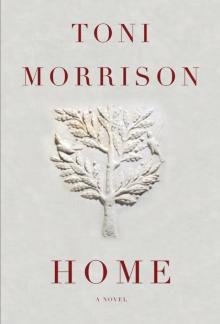 Home
Home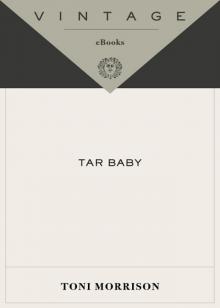 Tar Baby
Tar Baby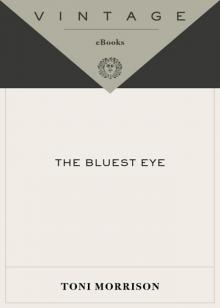 The Bluest Eye
The Bluest Eye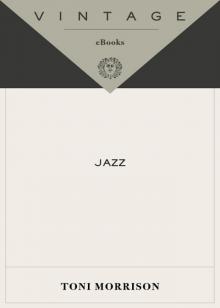 Jazz
Jazz Love
Love Sula
Sula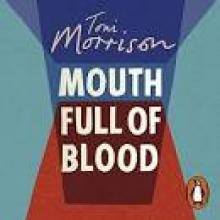 Mouth Full of Blood
Mouth Full of Blood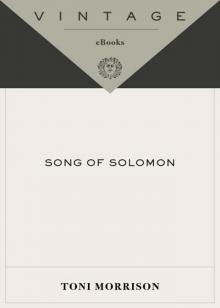 Song of Solomon
Song of Solomon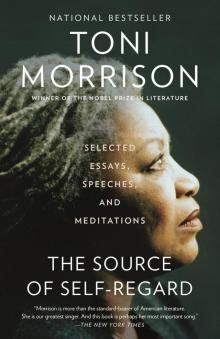 The Source of Self-Regard
The Source of Self-Regard A Mercy
A Mercy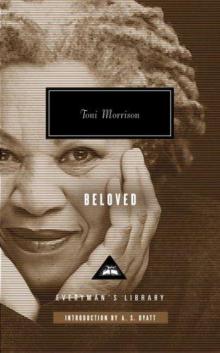 Beloved_a novel
Beloved_a novel